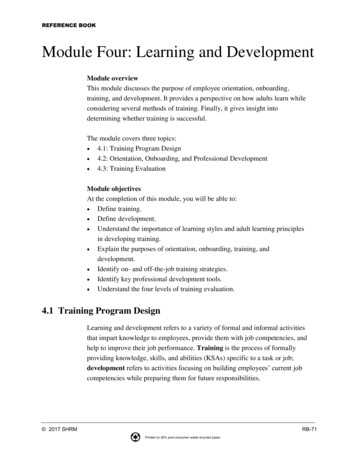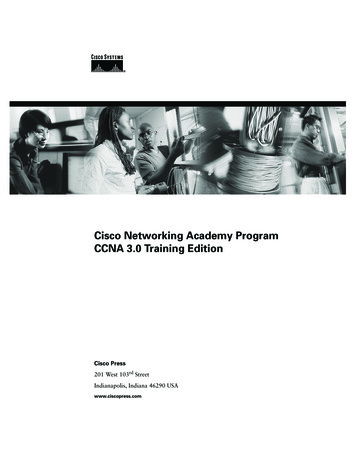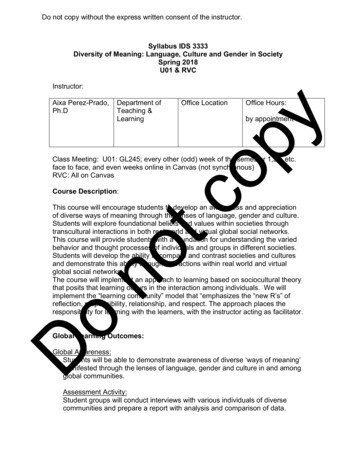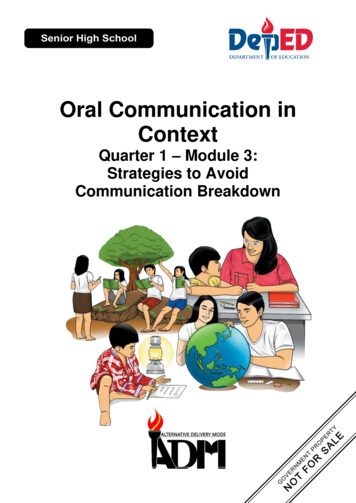
Transcription
REFERENCE BOOKModule Four: Learning and DevelopmentModule overviewThis module discusses the purpose of employee orientation, onboarding,training, and development. It provides a perspective on how adults learn whileconsidering several methods of training. Finally, it gives insight intodetermining whether training is successful.The module covers three topics: 4.1: Training Program Design 4.2: Orientation, Onboarding, and Professional Development 4.3: Training EvaluationModule objectivesAt the completion of this module, you will be able to: Define training. Define development. Understand the importance of learning styles and adult learning principlesin developing training. Explain the purposes of orientation, onboarding, training, anddevelopment. Identify on- and off-the-job training strategies. Identify key professional development tools. Understand the four levels of training evaluation.4.1 Training Program DesignLearning and development refers to a variety of formal and informal activitiesthat impart knowledge to employees, provide them with job competencies, andhelp to improve their job performance. Training is the process of formallyproviding knowledge, skills, and abilities (KSAs) specific to a task or job;development refers to activities focusing on building employees’ current jobcompetencies while preparing them for future responsibilities. 2017 SHRMRB-71Printed on 30% post-consumer waste recycled paper.
REFERENCE BOOKTraining teaches employees the basic skills they need to do their jobs.Learning, of course, occurs on an ongoing basis, with or without formaltraining. Training, however, accelerates the learning that is specific to theneeds of the organization. It is intended to close the gaps between anemployee’s current performance and the desired performance. Training isappropriate to support learning; it may also be a tool to correct someperformance issues.Training seeks to create a learning climate by adhering to the following: Learning is performance-based and tied to business objectives. The intent is to improve the employee’s KSAs. Importance is placed on how to learn, not just what to learn. Facilitators help employees develop critical thinking skills. Employees take responsibility for their own learning.The primary goal of a training program is to support the goals of theorganization and to ensure that employees are effective and efficient in theirjobs. It is not enough that employees gain new KSAs; they must be able toapply what they learn to improve and sustain good job performance. Workrelated training can be regarded as successful only if the learning transfers tothe job.Adult Learning Principles and Learning StylesWhen designing or selecting learning activities, it is important to consider adultlearning principles and learning styles. Both elements contribute to the qualityof the learning experience.Adult learning principlesThe table below lists some basic principles of adult learning.These principles provide insight as to how adults learn best and should be thestarting point for the design of training programs.RB-72 2017 SHRMPrinted on 30% post-consumer waste recycled paper.
MODULE FOUR: LEARNING AND DEVELOPMENTAdult Learning PrinciplesTraining Applications Adults want a focus on “real world”issues. Show how participants can immediatelytransfer the learning back to the job. Emphasis on how the learning can beapplied is desired. Apply training to current and futureneeds. Adult learners will come with goalsand expectations. Discover the participants’ expectationsat the onset of the program andaddress those that will not be covered. Allow debate and challenge of ideas,but adults must be motivated to keepdisagreements unheated. For some participants, this interactionenhances the learning. Create a safe learning environment. Listening to and respecting theiropinions is what adults expect. Promote a learning environment that iscollaborative between the instructorand the participants. Allow participants to receive feedbackfrom the instructor and each other. Adults will wish to be resources toyou and to each other. Allow for planning between theinstructor and the group. Take the knowledge and experience ofparticipants into account.Learning stylesLearning styles describe the ways individuals learn and how they process ideas.There are three distinct styles—visual, auditory, and kinesthetic (tactile). Visual learners learn best through seeing. These learners need to see bodylanguage and facial expression to fully understand content. They may thinkin pictures and learn best from visual displays, including diagrams, slidepresentations, and computer-based training. Auditory learners learn best through hearing. Verbal lectures,discussions, and listening are auditory learners’ preferred methods oflearning. These learners often benefit from reading text aloud or using arecording device. Kinesthetic (tactile) learners learn best through an activity-based(hands-on) approach. They prefer to actively explore the physical worldaround them. They may find it hard to sit still for long periods and maybecome distracted by their need for activity and exploration. 2017 SHRMRB-73Printed on 30% post-consumer waste recycled paper.
REFERENCE BOOKMost adult learners have a preferred learning style but are able to adapt to usethe other, non-preferred styles. Trainers and instructional designers should try toincorporate all three styles into their courses. Understanding learning styles andmodifying instruction to address all styles helps to increase the retention rate ofadult learners.Competency ConnectionCommunication: Listening is a key element of the Communicationcompetency. When designing training programs, HR professionalsmust use active listening to understand the perspectives and needs ofemployees. They may also use surveys or other tools to gatherfeedback from employees.Learning activitiesThe following are types of learning activities that are frequently incorporatedinto training programs. Using a well-balanced mix of learning activities thatincorporate various levels of participation is a good way to accommodate alllearning styles. There are no right or wrong learning activities; they depend onthe audience, the trainer, and the content to be covered.TypeDescriptionUseful When . . .Icebreaker activitiesActivities used at the beginning oftraining to allow a group to getacquainted and to encourageinvolvement and participation. Thistype of activity allows for earlyengagement of the learners andhelps set the tone for the course.The success of the seminar dependson the trainees’ ability to worktogether throughout the event.LectureThe primary purpose of lecture is toprovide information. For the mostpart, the trainer presentsinformation via slides or handoutsand communication is primarily oneway.There is a great deal of informationto be disseminated and the learner isnot expected to retain theinformation for the long term.Group discussionsTrainees take part in small-groupdiscussions designed to elicit avariety of ideas and viewpoints. Inmany cases, groups are given aproblem and asked to provide ananswer.The size of the group allows time fordiscussion and trainees arecomfortable working together.RB-74 2017 SHRMPrinted on 30% post-consumer waste recycled paper.
MODULE FOUR: LEARNING AND DEVELOPMENTTypeDescriptionUseful When . . .DemonstrationTrainees are shown how to performa task correctly. They are givenfeedback at appropriate stepsthroughout the process.Trainees will benefit from practicingin a nonthreatening environment, thetraining environment supports suchpractice, and the trainer is skilled inthe task.Role playsTrainees assume roles and act outsituations related to the job.The training environment allowstrainees to take risks and makemistakes. Trainers are skilled atproviding feedback and identifyingteaching points.Case studiesCase studies are descriptions ofreal or hypothetical job situationsthat contain information thattrainees will analyze to understandwhat has occurred and why. Basedon the information provided,trainees will formulate responses tothe situations.Trainees are preparing for a role thatis new to them—for example, amanagement or executive role—andthe cases are relevant to their jobs;also useful when there is a skilledtrainer and adequate time to discussand debrief the complexities of thecases.ScenariosScenarios are similar to casestudies but are usually fictional andlimited in length and learningobjectives.Trainees have sufficient knowledgeof the concepts behind scenarios todescribe appropriate responses toquestions. Trainers are skilled atproviding feedback.SimulationsSimulations are similar to casestudies but are generally morecomplex and are highly interactive.The path of the simulation is oftendirectly tied to the trainee’sdecisions.Trainees have adequate time toparticipate in the simulation andwhen it is important for trainees tosee the link between their decisionsand the results.Developing Training ProgramsA five-step instructional design process commonly referred to as the ADDIEmodel serves as a guide for training program development and implementation.The steps, followed in order, lead to the development of training programs thatenable the organization to meet its mission, goals, and objectives.The diagram on the next page visualizes the ADDIE process and provides anexample for each step of the process. The example is based on the developmentof a training program for employees who sell replacement cartridges for printers. 2017 SHRMRB-75Printed on 30% post-consumer waste recycled paper.
REFERENCE BOOKRB-76 2017 SHRMPrinted on 30% post-consumer waste recycled paper.
MODULE FOUR: LEARNING AND DEVELOPMENTWhile the ADDIE model is preferred by SHRM, HR professionals should beaware that other instructional design models may be used. Unlike ADDIE,which is a linear process, the Successive Approximation Model (SAM)develops training in multiple design and development phases that are brokendown into small steps. Agile is a version of SAM that emphasizes collaborationand feedback. In the agile method, design, development, implementation, andevaluation occur iteratively so that changes can be made quickly.Types of TrainingOn-the-job trainingOn-the-job training (OJT) is training provided to employees at the work siteutilizing demonstration and performance of job tasks. OJT can be highlystructured or informal. Either the employee’s manager or an experienced coworkerassumes the role of trainer. The ultimate effectiveness of the training effortdepends on the trainer’s expertise and the time and personal commitment he or shegives to the effort. When done well, OJT can be highly effective and can bring atrainee’s performance up to standards quickly. OJT is the preferred trainingmethod of many organizations because: The transfer of learning to the job is enhanced. Training occurs in the jobsetting. Training is relatively inexpensive. It involves no separate facility and noprofessional trainer. Trainees are motivated to learn. The relevance of the training is typicallylinked to outcomes that will benefit the employee.A possible disadvantage of OJT is its dependence on the skills andcommitment of the “trainer.” Managers or experienced coworkers who do nottake their role seriously or who have limited time to train the employee oftenleave the trainee in a “sink or swim” predicament. If the trainer is ineffective orif there are too many competing demands on the trainer’s time, the traineesuffers the consequences.The following table reviews some of the more common forms of on-the-jobtraining. 2017 SHRMRB-77Printed on 30% post-consumer waste recycled paper.
REFERENCE BOOKOJT MethodDescriptionFormal trainingUsually provided in a classroom or meetingroom at the work location and led by aninstructor, manager, or experienced colleague.Learner-controlledinstructionUsually provided in the form of computer-basedinstruction, trainees are able to progressthrough this type of training at their own pace.Apprentice trainingTrainees work with an accomplished, skilled,and certified worker to learn their craft. This ismost common in union environments andskilled crafts (e.g., plumbing, carpentry,welding).ShadowingTrainees spend a period of time observing anexperienced employee who performs the worktasks associated with the requirements of thejob.Off-the-job trainingOff-the-job training occurs away from the actual work site, often in anorganization’s training facility or a hotel conference room. Depending on thetraining content and the materials involved, it can be the most economical wayto deliver training to a group of employees.Advantages include the following: The controlled environment ensures that all attending trainees will receivethe same information. When they are removed from the daily demands of their jobs, trainees canfocus more fully on the training task. Organizations may use professional trainers from outside the organizationwho can often enhance the effectiveness of training while introducingtrainees to novel points of view (helping them to think “out of theorganization’s box”).The main challenge of off-the-job training is to ensure that the design of thetraining incorporates methods that will help trainees transfer to the job whatthey learn in the classroom.RB-78 2017 SHRMPrinted on 30% post-consumer waste recycled paper.
MODULE FOUR: LEARNING AND DEVELOPMENTCommon off-the-job training methods include: Workshops. Conferences/seminars. Simulations. Multimedia. Case studies and scenarios. Role plays and management games. Computer- or web-based learning.Consider . . .Business Acumen: Your manager has asked you to put together abudget for the upcoming performance evaluation training sessions that allemployees will attend. This requires you to determine if you will use aninternal or outside trainer. After a thorough needs analysis, youdetermine that hiring an outside consultant is the best option. You contactthree possible training companies and request a proposal from each.4.2 Orientation, Onboarding, and Professional DevelopmentAn organization relies on its employees to help meet its goals and objectives.Through employee orientation, onboarding, and professional development, anorganization ensures that its employees understand the business of theorganization and have the critical skills necessary to work safely and effectively.OrientationOrientation is the first step in the formal process of training employees.Through orientation, employees become familiar with the organization, theirdepartment, their coworkers, and their job. The purpose is to help them becomeproductive members of the organization as quickly as possible.The orientation process is often divided into two parts—general orientation anddepartment orientation. While HR serves as a valued coach/counsel to eachmanager, it is ultimately the manager’s responsibility to ensure that employeesunderstand how they fit into the organizational structure and how theycontribute to the overall success of their department. The illustration below 2017 SHRMRB-79Printed on 30% post-consumer waste recycled paper.
Explain the purposes of orientation, onboarding, training, and development. Identify on- and off-the-job training strategies. Identify key professional development tools. Understand the four levels of training evaluation. 4.1 Training Program Design. Learning and development










